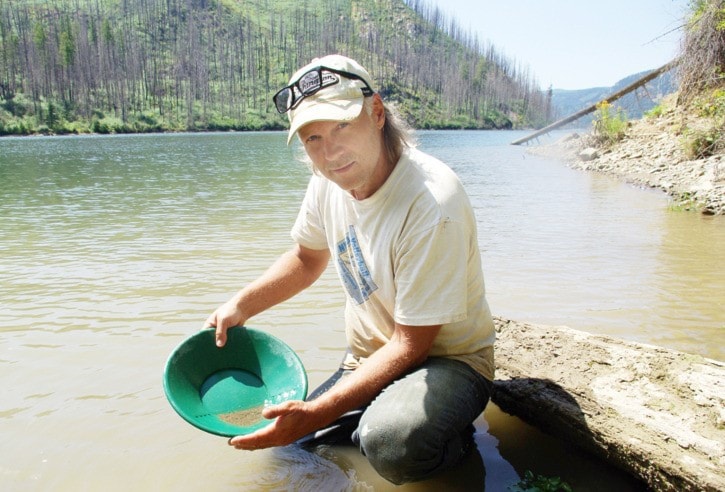Just as old prospectors did over 150 years ago, a Trail native digs into the bench of the Pend D’Oreille riverbed in search for gold.
Terry Crockett started panning as a hobby about four years ago in Arizona, when an 80-something-year-old man with 50 years experience unloaded his knowledge over the course of three days.
After 16 years out of country, the 47-year-old is back home and settled on a claim along the ancient riverbed, where, if he’s not catching gold fever, he’s photographing osprey or juvenile eagles that swoop overhead.
“The whole thing with gold is it’s heavy, it’s 19 times heavier than water,” he said, as he rotates his pan and separates the black sand from tiny specs of gold. “When you pan out, you’re washing it and cleaning it up and getting rid of the light material to get to the heavy gold that sits at the bottom.”
Though he owns some equipment – like a highbanker, which is a mobile sluice box that uses a pump to transport the water and minerals to another location – he doesn’t need much when he’s scraping into bedrock.
With a full pan in hand, Crockett has the luxury of resting on a log this time. His wasp-bit hands and knotted back are just a few symptoms of his physically draining hobby.
“I like the freedom aspect of it and the idea that you could come into a pocket of a bunch of gold – that’s the excitement of it,” he said.
“It’s not about getting rich, I’m more realistic than that, but there is always that chance that you can get into a pocket and be like, ‘Wow, look at this.’”
Panning may not be a get-rich-quick plan but it is a shot at adding to his savings. Crockett doesn’t hold much faith in the world economy and rather bank physical gold or silver as currency for retirement.
“The U.S. is bankrupt and they’re going to collapse and when that happens the whole world economy is going to go down,” he said. “The reason why gold is going high is because the U.S. dollar is collapsing and when that finally happens gold is going to go crazy, price wise.”
The price of gold is soaring, topping out near $1,750 an ounce, which is far more than the $900 it was going for in 2008. Investors continue to put their money into gold because it’s deemed the safest asset during a time of economic uncertainty.
“It wasn’t a fluke it was fate that I met that guy who taught me how to pan,” said Crockett, acknowledging the gold that runs deep in his hometown. “This is our history, it’s why we’re here.”
Gold was discovered in 1855 where the Pend d’Oreille River joins the Columbia River. The Dewdney Trail –stretching from Fort Hope to the gold fields near Fort Steele in the East Kootenay – opened this area up to mineral exploration, the development of mines, and later, to logging and hydroelectric power generation.
In 1856, Angus McDonald of Fort Colville sent prospectors into the Pend d’Oreille valley in search for placer gold and as a result 220 ounces of gold were sent to Victoria.
Now owning the mineral rights to what Crockett believes to be a former homestead, the old soul continues the dirty work.
Self-employment is the only route for the Libertarian, who makes a living as a videographer and photographer. Prior to discovering a passion behind the lens, Crockett fell into many odd jobs, including cars salesman, construction, musician in which he was an original member of the local band Roughshod.
“I don’t believe in the myth of go to work and at 60 or 65 you get to retire and live happily ever after,” he said. “I’d like to live now.”
